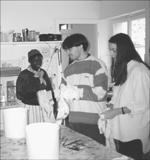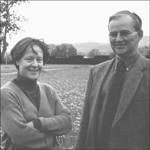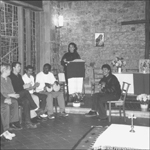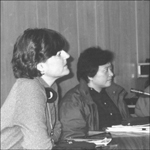When she was asked how her ministry will be different because of her most recent educational experience, Laura Beaver didn’t miss a beat. “Any church I go to serve,” she said, “the first thing I’ll do is hang up a map of the world. I want people to know that their church is just a part of something that is very much bigger.” Beaver, a student at Wesley Theological Seminary in Washington, D.C., has just returned from a semester at the graduate school of the World Council of Churches’ Ecumenical Institute in Bossey, Switzerland. There, along with forty-four other students from twenty-seven countries and a broad array of Christian traditions, she says she “learned that countries have faces.”
The institute has been teaching that lesson, among others, for more than fifty years now. A student enrolled during the school’s third year wrote, “The presence of the German group in Bossey in 1948 was particularly significant. Born in Hungary of Jewish ancestry, a Hitler refugee, I harbored a deep distrust toward all Germans, a wholesale prejudice. Thanks to those at Bossey, I learned to consider Germans once again as individuals.”
Noel Suministrado, a current student and a pastor of the United Church of Christ in the Philippines, put it succinctly, “Bossey completely shakes you inside out,” he said.

|
| Life in community isn't just spiritual and academic: somebody has to pull kitchen duty.
|
The lessons are learned in a one-of-a-kind setting. The eighteenth-century chateau, a twenty-minute drive from Geneva, sits quietly on sixty-nine acres surrounded by fields and cow pastures that overlook Lake Geneva and the mountains beyond. The core of the program is the two semesters of graduate school during which students live together and work with half a dozen faculty around a common theme. Other programs fit in and around these, with short-term events and a dozen or so seminars each year. On offer this summer are “Religious Dreams and Symbols,” “Armenian Spirituality,” and “Post-Colonial Hermeneutics.”
Shared Living as Learning
Both the shared living and the study are part of Bossey’s unique learning experience. The students do not all speak the same language. Classes happen in French and English, with simultaneous translation. For many students, of course, neither tongue is a first language, so much extracurricular activity is carried out in “ecumenical French” and “ecumenical English.”
Mealtimes provide their own challenges. The food is pretty solidly European. (A Nigerian student said, “I had a bad tummy for two months.”) Even when they have adjusted to the food, there are still table manners. (“Do you have any idea how many right ways there are to butter bread?” asked another.)
In the classroom, students are challenged to articulate their own traditions in ways they would never have to in either a denominational school or in a multiconfessional school in their own countries. Add to the mix a faculty that is interdenominational and multicultural. This year it comprises a Samoan Congregationalist, a Romanian Orthodox, an Uruguayan Methodist, a Tanzanian Roman Catholic, and a Presbyterian from the United States.
Here again, beyond matters of doctrine, are matters of style. Laura Beaver says that the sharpest moment of conflict in her Bossey experience came when “some of us—mostly Americans—had some issues with the teaching methods of one faculty member, which were lecture-oriented and, we thought, authoritarian. When we voiced this, some students were horrified that we were trying to get the teacher fired! We were doing no such thing. But then the issue of how to resolve the issue was even more complicated. Some wanted to discuss it in small groups. Some wanted to write a document. Some thought our oldest student should decide, as our nearest equivalent to a village elder.” She doesn’t remember exactly how things were resolved, only that they were.
Over the years, students have wrestled with issues from the political to class, race, and gender issues to the increasing participation of Orthodox and Roman Catholic students. An issue at the fore today seems to be interfaith dialogue, and indeed, not only did Bossey recently welcome its first Muslim student, but last year’s graduate school focused on religious pluralism. And the strength of the program is not that issues are resolved once for all—they aren’t—but that students gain skills of understanding and of shared struggle.
Styles of Teaching and Learning
This is not to suggest that academics are lacking. Indeed, pedagogy has been one of the focuses of current director Heidi Hadsell’s tenure. “We introduced a series of conversations about teaching interdenominationally and cross-culturally. Now the first lecture students get is about ways of learning,” she explained with obvious pleasure.

|
| Director Heidi Hadsell and development director John Lindner are both leaving the scenic shores of Lake Geneva for new pursuits.
|
One result of these conversations has been a raising of the bar for the graduate school. There is closer cooperation with the University of Geneva, and about a quarter of graduate school students are involved in the new master’s program in ecumenical studies which includes two semesters of study and a thesis. Noel Suministrado, a participant in the 1998 graduate school who returned for the master’s program, agrees that things have changed. “Students are more engaged, more enthusiastic, and have a greater sense of responsibility toward their whole learning experience,” he said. “It is stretching me.” His thesis has to do with globalization and interreligious ethics—which he describes as a “heady brew.” Each semester is divided into modules (students choose two of four) that include lectures, presentation of student papers, and seminar work. The balance piece to increased academic rigor in the graduate school has been a slight lowering of the bar in seminars, which are less academic and more pointedly aimed at lay people.
Hadsell’s tenure at Bossey is drawing to a close. She was elected president of Hartford Seminary in Connecticut last year, and Ioan Sauca, an Orthodox priest from Romania who has spent several years on the faculty, has been named her successor at Bossey.
During the transition, Hadsell has been living a bicontinental life, simultaneously finishing one job and beginning another. “It’s busy. It’s wild. It’s lots of fun,” she said. This is a woman of considerable energy who can even find ways to use the time difference to advantage, although she admits that it’s a challenge to remember what paper is where. She sees some connections between her work at Bossey and what she will be doing at Hartford. Hartford’s Institute for Religious Research is focusing on interfaith issues, which puts her in mind of the “Christian Identity in a Religiously Plural World” graduate school session at Bossey. And Hartford’s new Institute for the Study of Islam has both Christian and Muslim students, which she says is, “like Bossey in that being with other traditions sharpens awareness of your own.”
The Worship Lab
Hadsell pronounces her experiences in chapel as the most life-changing aspect of her time at Bossey’s helm. “The worship, daily worship across traditions in community,” she replied to a questioner. Her point is well taken. Bossey’s chapel is simple. It would be austere were it not for a bright stained-glass wall designed by a brother from Taiz and an assortment of icons. It is enlivened every morning when virtually all of the community gathers for worship. The liturgy is varied: the only safe assumptions are that it will be multilingual and involve scripture, prayer, and singing. One recent week included a memorial service for Africans who died in the middle passage, a celebration of the anniversary of the Lutheran-Roman Catholic joint declaration on justification (which featured vested members of those traditions processing in to strains of “Veni Creator Spiritus”), and an unornamented service with a reading, a hymn, and a sermon by a member of a group that was visiting for a few days. Regularly used songbooks include the Taiz community’s and Thuma Mina, published by the World Council of Churches, but worshipers are just as likely to find themselves singing an altered version of West Side Story’s “One Hand, One Heart” or “How Great Thou Art.”

|
| Bossey worship is multi-lingual as well as multi-traditional.
|
Striking and varied artwork can be found in odd spots around the chateau. The dining hall features a large painting which appears to be a black St. Christopher; a student explains, “No, that’s the African church carrying Christianity to safety.” On the tree-lined path to the library, one is suddenly confronted with a fifty-foot totem pole, made for the Vancouver assembly of the World Council of Churches by First Nation Canadian prisoners, and later shipped to Switzerland.
Keeping Connections
Those who have experienced the school are enthusiastic. The class of 1956 still gets together every year or two. When the institute celebrated its fiftieth birthday by encouraging friends of Bossey to get together and reflect on what ecumenical formation has meant for them, twelve former students gathered in Myanmar, some of them walking several days to reach the meeting.
Formal connections between the institute and its former students (about 2,500 from the graduate school and perhaps four times that number from other programs) have not always been so close. “When we started rebuilding the lists,” said John Lindner, the institute’s director of development, “we had about fifty names with good addresses.” He was circulating lists of names when he got a series of gleeful calls about one Frank Lazor explaining that he was easy to find if one called him by his current name—Metropolitan Theodosius, head of the Orthodox Church in America.
One use made of the list of students was some research on the role Bossey played in their subsequent lives. Fully a third of the Americans surveyed said that their time at the institute had led to major concrete changes in their careers. (Sometimes personal lives are changed concretely, too: Szilvia Nagy, a Lutheran pastor, and Szabolcs Nagpal, a Roman Catholic, both Hungarian, met at Bossey, were married, and returned for this year’s master’s program.) Another telling statistic had to do with how many of these students—64 percent—had received some financial assistance and could not have participated without it. Consider that these are students from the United States, and you can imagine what the percentage is like in less wealthy countries.
Growing Costs
Students keep on coming. This year the faculty in its role as selection committee turned down four applications for every one they accepted. And they don’t come cheap: the approximate cost of a semester at the graduate school is $7,500, $18,000 for the master’s program—not including travel. Just over three-quarters of students need full scholarships; neither they nor their denominations (which must approve their attendance) are able to help pay.

|
| Laura Beaver, left, makes a point in a seminar. "It's been the deepest educational experience of my life," she said.
|
And, of course, it’s not just the students that require funding. The chateau has not had a major overhaul since the institute acquired it, and it is in need of some modernization. It is an accessibility nightmare, with multiple levels, chapel and dining room in separate and unconnected buildings, and a plumbing system whose idiosyncrasies lend credence to tales of a haunting. The bedrooms ooze charm, but trying to arrange lighting so one can actually see to work at night is a challenge. So a plan is in place—and work is well underway—to put bathrooms into bedrooms, link the buildings, install elevators, refurbish what needs refurbishing, and consolidate administrative offices. The new dining hall will offer a wider choice of food, thus alleviating some unnecessary cultural dissonance for newcomers. The most recent cost estimate was around $5 million, but rethinking accessibility might push costs higher.
All of this is occurring at a time when traditional sources of funding like mission boards of mainline denominations are cutting back on funding of programs beyond their own. Where is the money coming from?
Growing Resources
Lindner’s approach and his five-year development plan is—to say the least—diversified. He courts large gifts, like the $1.5 million the United Methodist Church gave to endow a faculty chair. He rejoices in smaller gifts—he tells a tale of finding himself on a big-city street late at night with a bag full of cash after a church service had proven fertile ground for sharing the story. He has a business plan, too, that includes increased use of the chateau by outside groups between semesters. He cherishes the usual round of gifts from congregations and individuals, and has made it easier for people in the U.S. to donate by channeling funds through the ecumenical trust, which is administered by the Presbyterian Church (U.S.A.). He travels widely telling the Bossey story—in March he took half the faculty to Claremont (California) School of Theology for a conference called “Beyond Boundaries: The Changing Face of Christianity.” (“Beyond Boundaries” also happens to be the name of Bossey’s newsletter.) And he’s entirely happy to bring groups to the chateau.
The ecuhostel, for example, is an occasional event that involves organizing a travel seminar aimed primarily at members of wealthy and influential congregations. The study program is big-name and serious (Konrad Raiser, the general secretary of the World Council, spent an afternoon with a recent group) but accessible to the theologically unlettered. The experience of the chateau is honest—delightful but just uncomfortable enough to make the need for renovation obvious (the plumbing challenges at a recent hostel were unplanned but made a point). The sell is subtle but consistent; Lindner is unapologetic about the fact that these events have led to generous gifts—and to new and interesting ecumenical initiatives when the travelers return home. Time at the chateau includes lots of interaction with students, who are gracious even when asked startlingly naive questions, and is broken up with off-campus adventures, including shopping and sightseeing trips. And there is usually just enough diversity in the groups to make for some authentic ecumenical dialogue.
Ecumenical Laboratory
It is hard to guess how Bossey will change in the years ahead: the changing face of the world and of the church will doubtless continue to guide it. And since those involved in the school have been calling it a laboratory for many years now, nobody is overly distressed at the possibilities: the process by which the school reinvents itself has proven trustworthy, and the institute will continue to serve as a resource to the theological community.
Your school is not going to become Bossey, nor should it. Perhaps you or someone from your school should visit the extraordinary place. More to the point, after fifty years the lessons your institution can learn from it are pretty clear. Theology cannot be learned in one language: to grasp the gospel is to see it through a variety of eyes. The day-to-day world of your graduates is becoming more culturally and religiously varied all the time, and people doing ministry need to have experienced a community in which their viewpoint is not the obvious, the only one. There are any number of ways to provide that learning experience for your students, but Laura Beaver got it right: you need to help your students find faces for abstractions.